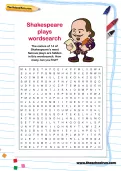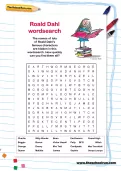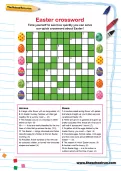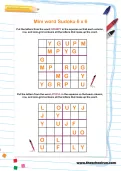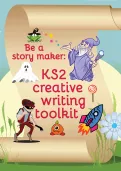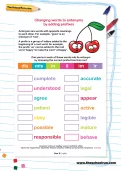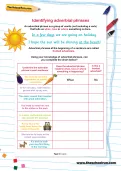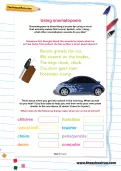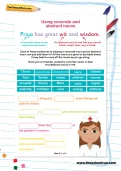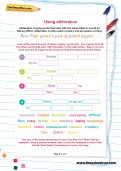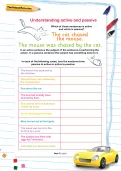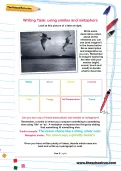Does your child long to write stories? Our KS2 creative writing toolkit is packed with writing prompts to inspire them and gorgeously-illustrated pages to write on.
or
Register to add to your saved resources
Already a subscriber? to view this content.
A subordinate clause contains a subject and a verb, but it needs to be attached to a main clause because it cannot make sense on its own. Clauses can be linked by conjunctions, prepositions and adverbs. Adverbs are used to show sequence (eventually, finally, meanwhile), contrast (however, on the other hand) or cause and effect (therefore, subsequently). Which of the red adverbs from inside the brackets above would fit into the sentences below?
or
Register to add to your saved resources
Already a subscriber? to view this content.
Synonyms are words that have similar meaning. For example: ‘overjoyed’ is a synonym for ‘happy’. Cut out the following words. Can you match up the pairs of synonyms?
or
Register to add to your saved resources
Already a subscriber? to view this content.
Antonyms are words with opposite meanings to each other. For example, ‘good’ is an antonym of ‘bad’. A prefix is a group of letters added to the beginning of a root word; for example,
the prefix ‘un’ can be added to the root word ‘happy’ to make the word ‘unhappy’. Can you turn each of these words into its antonym by choosing the correct prefix from this row?
or
Register to add to your saved resources
Already a subscriber? to view this content.
Ellipsis literally means to leave something out. Ellipsis (or suspension points) are a form of punctuation represented by three dots. In a story, we might use ellipsis if someone starts a sentence but
doesn’t finish it. It is also often used to build suspense at the end of a paragraph or chapter. Where and why has ellipsis been used in this extract from a story?
or
Register to add to your saved resources
Already a subscriber? to view this content.
Sometimes we use hyphens to join a prefix and a root word, especially if the prefix ends with a vowel and the root word starts with a vowel. Cut out these prefixes, hyphens and root words. See if you can assemble them to make words.
or
Register to add to your saved resources
Already a subscriber? to view this content.
In writing, an ellipsis (...) shows that something has been left out or that someone has started a sentence but hasn’t finished it. It can also be used to build suspense at the end of a paragraph or chapter. Where and why has ellipsis been used in this story extract?
or
Register to add to your saved resources
Already a subscriber? to view this content.
Dashes can be used to indicate parenthesis (brackets can be used for the same purpose). Where do you think the dashes should go in these sentences?
or
Register to add to your saved resources
Already a subscriber? to view this content.
An adverbial phrase is a group of words (but no verb) that tells us when, how or where something is done. Using your knowledge of adverbial phrases, can you complete this chart?
or
Register to add to your saved resources
Already a subscriber? to view this content.
Sometimes dashes are used to indicate a pause in sentences that contain two independent clauses. Look at these sentences and add in the dash where you think it should go in each one.
or
Register to add to your saved resources
Already a subscriber? to view this content.
Sometimes dashes are used in sentences to link different clauses and indicate a pause or break in the flow of a sentence. Look at these sentences and write in a dash where you think it should go in each one.
or
Register to add to your saved resources
Already a subscriber? to view this content.
Can you add the missing dashes into these sentences?
or
Register to add to your saved resources
Already a subscriber? to view this content.
Can you match up the collective nouns on the left with the correct nouns on the right?
or
Register to add to your saved resources
Already a subscriber? to view this content.
Onomatopoeia is describing a sound by using a word that actually makes that sound. Splash, whir, clang... what other onomatopeic sounds do you like? Think about when you get into school in the morning. What sounds do you hear? Use this table to help you and then write your own poem similar to the one above (it doesn’t have to rhyme!).
or
Register to add to your saved resources
Already a subscriber? to view this content.
Each of these sentences is missing a concrete noun and an abstract noun; can you add them in? Once you’ve finished, underline concrete nouns in blue and abstract nouns in red.
or
Register to add to your saved resources
Already a subscriber? to view this content.
Alliteration is using words that start with the same letter or sound for literary effect. Alliteration is often used in poetry and persuasive writing. Look at the name in each of these ‘empty’ sentences. You need to find all the other words that start with this letter in the table below. See if you can work out how to organise the words so that the sentences make sense.
or
Register to add to your saved resources
Already a subscriber? to view this content.
In each of the following cases, turn the sentence from passive to active or active to passive.
or
Register to add to your saved resources
Already a subscriber? to view this content.
These sentences contain a subject, verb and object. Underline the subject in green, the verb in purple and the object in orange.
or
Register to add to your saved resources
Already a subscriber? to view this content.
See if you can turn these active sentences into passive sentences.
or
Register to add to your saved resources
Already a subscriber? to view this content.
Look at this picture of a lake at night. Write some descriptive notes about all the elements you can see (and imagine!). Be as descriptive and imaginative as you can. Now can you turn any of these descriptions into similes or metaphors?
or
Register to add to your saved resources
